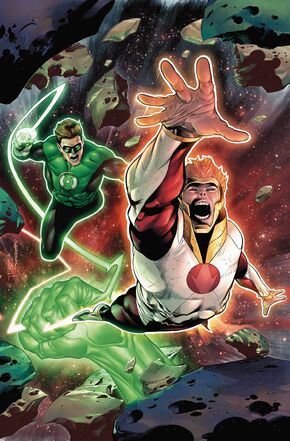| Lightray | |
 | |
| Publication information | |
|---|---|
| Publisher | DC Comics |
| First appearance | New Gods #1 (February 1971) |
| Created by | Jack Kirby (writer - artist) |
| In-story information | |
| Alter ego | Solis |
| Species | New God |
| Place of origin | New Genesis |
| Team affiliations | Justice League International New Gods Justice League |
| Abilities |
|
Lightray (Solis) is a DC Comics superhero. Created by Jack Kirby for the "Jack Kirby's Fourth World" meta-series, he first appeared in New Gods #1 (February 1971).
Lightray was a major character in New Gods volume 1 (1971-1978), as well as volume 2 (1984), volume 3 (1989-1991) and volume 4 (1995-1997). He has also appeared with Orion in the Cosmic Odyssey limited series (1988-1989), Jack Kirby's Fourth World (1997-1998) and Orion (2000-2002).
Seven years after the character's creation, Lightray's origin story was revealed in DC Special Series #10, a Secret Origins of Super-Heroes issue that was published in January 1978.
The version of the character in current DC continuity was introduced in Green Lantern/New Gods: Godhead #1 in December, 2014.
Fictional character biography
Lightray is the shining star of New Genesis and a high-spirited New God. Unlike his grim friend Orion, Lightray is cheerful and optimistic and prefers to solve problems through compromise rather than combat. He uses the speed of light to his advantage in eluding foes.
Lightray has served one stint as a member of the Justice League. He joined the international branch along with Orion on the same night as a membership drive failed to find other new recruits. The difference between the two was illustrated in battle. While Lightray desires a minimum of fuss in battle by dispatching his foe Crowbar with a simple expenditure of energy to the man's face, Orion preferred to destroy the pavement around Blackrock, only to then be angered when his opponent surrendered instead of fighting to the death.
In this same issue, Lightray demonstrates his knowledge of chess. Lightray's long hair causes him to be mistaken for a girl by the old-fashioned General Glory. They stay with the team until just after the battle with General Glory's old foe the Evil Eye.
As Solis his idea of fun is protecting New Genesis from Apokolips, Darkseid, and his minions. He resides on New Genesis and is active in adventuring. He returns to Earth briefly in JLA #27 (March 1999), as part of an emergency expansion of the Justice League. The team battles the android Amazo in the Florida Everglades. Most of them are subdued and their powers copied, Lightray included. Amazo loses his powers when Superman, as the chairman, officially disbands the League, thus ending Lightray's membership.
He would appear again to aid the League alongside Orion and Big Barda when the planet Qward attacked earth with a giant ship.
In Countdown #48, Lightray falls to earth after an off stage fight with the New Gods Killer (later revealed to be Infinity-Man). He dies holding Jimmy Olsen's hand, repeating the word "infinite" and glowing brighter.
In Final Crisis #7, Lightray is depicted standing alongside Barda and Mister Miracle following the reincarnation of New Genesis on the ruins of Apokolips.
Powers and abilities
Like all the New Gods, Lightray is functionally immortal and possesses great superhuman strength, endurance and reflexes. Lightray is able to lift several tons with ease. His reflexes and durability are also more than amazing and he has a limited degree of invulnerability. Lightray flies at the speed of light or even faster, and can generate and project solar energy. Thus, he can create brilliant light and extraordinarily high levels of heat. He can focus his solar energy into beams of laser-like intensity. Lightray can also use his powers of light to create life-like illusions.
Using his power to the maximum, he can generate a huge sun or a nova explosion. Although Lightray has a pacifist personality and isn't a highly experienced warrior, he is well trained in hand-to-hand combat, but he prefers to use his solar powers in battle. In his headgear Lightray carries one of the powerful "living computers" called Mother Box.
Alternate versions
Seven Soldiers of Victory
Lightray makes several brief, non speaking appearances in Grant Morrison's Seven Soldiers of Victory series, where his human form is a frail man on crutches.
Captain Carrot
In the miniseries Captain Carrot and the Final Ark, Lightray's counterpart in the "New Dogs" is an anthropomorphic dog named Lightstray.
JLA: The Nail
In the 1998 Elseworlds JLA: The Nail, Lightray is depicted fighting in a war between New Genesis and Apokolips.
In other media
Television
- Lightray appears in the Superman: The Animated Series episode "Legacy" Pt. 2, in a non-speaking role.
- Lightray appears in the two-part Justice League episode "Twilight" voiced by Rob Paulsen. When Batman and Wonder Woman arrive on New Genesis to look for Orion, Lightray taunts them, giving Wonder Woman a playful slap on the behind, prompting her to declare "He's worse than the Flash!". This leads to a chase around New Genesis as Batman manages to trap Lightray as Orion arrives. Lightray was later seen with Batman, Wonder Woman, and Orion when they meet with Highfather.
- Lightray returns in an unspeaking role in the Justice League Unlimited episode "Destroyer." He encounters Lex Luthor, Sinestro and the Secret Society near New Genesis after they have accidentally resurrected Darkseid only to be attacked and have his Mother Box stolen by Evil Star, which the villains use to return to Earth, their base having been destroyed by Darkseid. His fate after Evil Star steals his Mother Box is unknown.
Film
- An alternate universe version of Lightray appears in Justice League: Gods and Monsters voiced by Trevor Devall. He partakes in the betrayal of Darkseid and is murdered by Bekka when he attacks her.